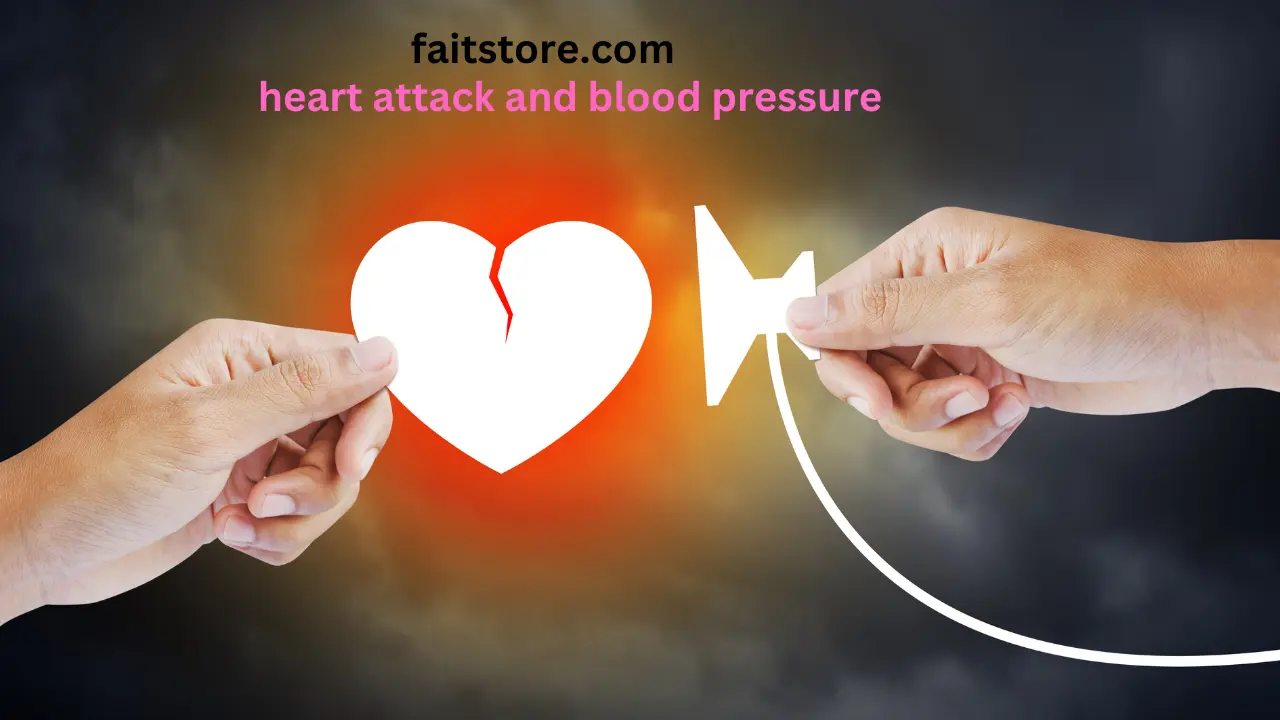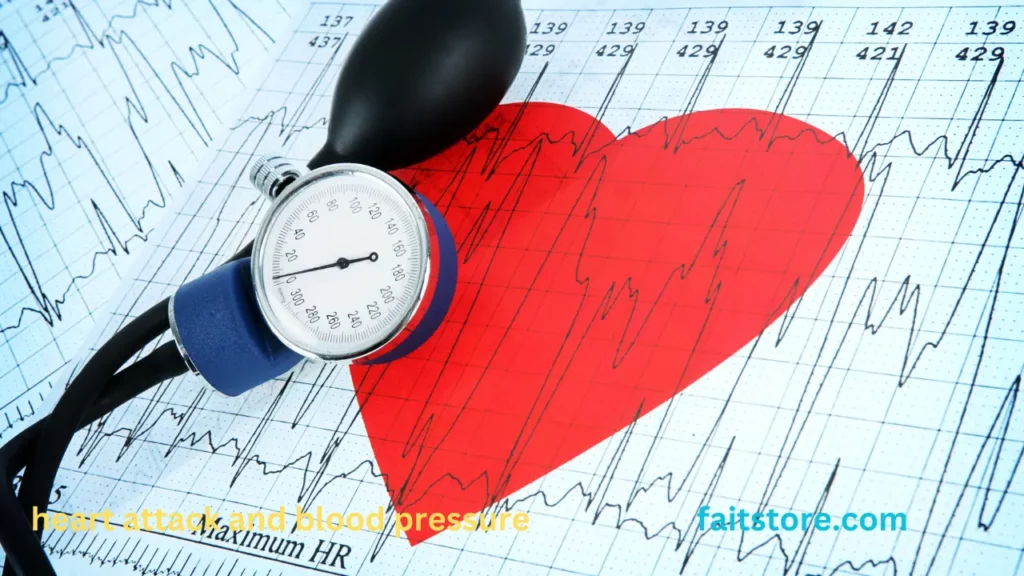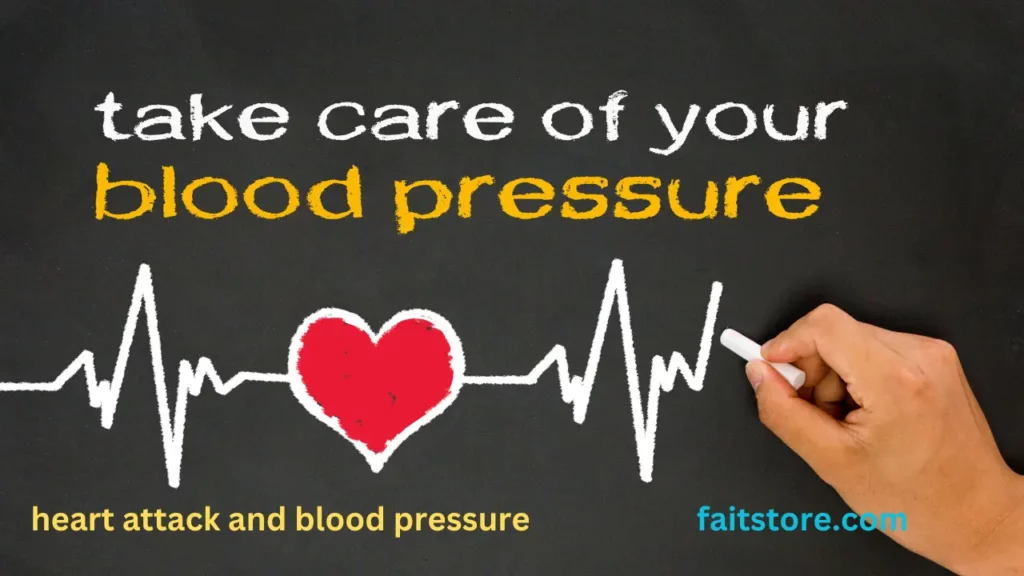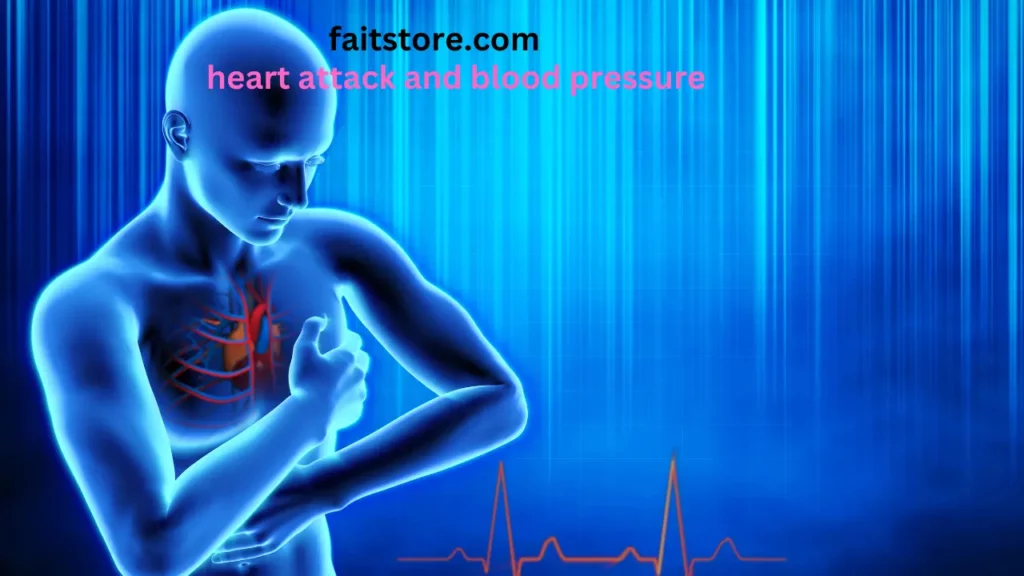
heart attack and blood pressure
Are you concerned about your heart health? Are you aware of the risk factors and warning signs of heart attack and high blood pressure? As a leading cause of death worldwide, heart attack and high blood pressure are critical health issues that require attention and understanding. Will delve into a heart attack and blood pressure, including their causes, risk factors, diagnosis, treatment, and prevention. So, let’s dive in and learn more about these two vital aspects of cardiovascular health. Heart attack and blood pressure
What is a Heart Attack?
A heart attack, also known as a myocardial infarction (MI), occurs when the blood flow to the heart is blocked, leading to damage or death of a part of the heart muscle. The blockage is typically caused by a blood clot forming in a coronary artery that supplies oxygen-rich blood to the heart. Without oxygen, the heart muscle can be severely damaged or die.
Heart attacks often cause chest pain or discomfort, as well as other symptoms such as shortness of breath, sweating, nausea, lightheadedness, and pain in the arm, jaw, neck, or back. Suppose you or someone else is experiencing these symptoms. In that case, it is important to seek medical attention immediately, as early treatment can prevent further damage to the heart and increase the chances of survival. Heart attack and blood pressure

Causes of Heart Attack
There are several common causes of heart attacks, including:
- Coronary artery disease: The most common cause of heart attacks is coronary artery disease when the coronary arteries that supply blood to the heart become narrowed or blocked by plaque buildup. Plaque is a combination of cholesterol, fat, calcium, and other substances that accumulate in the arteries over time, reducing blood flow to the heart muscle.
- Blood clots: Blood clots can form inside the coronary arteries, blocking blood flow to the heart and triggering a heart attack. Blood clots can form due to ruptured plaque or other factors that disrupt the normal flow of blood in the arteries.
- Spasm of a coronary artery: In some cases, the coronary arteries may spasm or constrict suddenly, reducing blood flow to the heart and causing a heart attack. This can occur even in the absence of significant plaque buildup.
- Risk factors: Certain risk factors increase the likelihood of experiencing a heart attack. These include smoking, high blood pressure, high cholesterol levels, obesity, lack of physical activity, a family history of heart disease, diabetes, and stress.
- Drug use: Certain drugs, such as cocaine and amphetamines, can increase the risk of heart attack by causing damage to the coronary arteries and triggering spasms.
- Other factors: Other factors that can contribute to heart attacks include hormonal imbalances, radiation exposure, infections, and inflammation of the arteries.
It’s important to note that heart attacks can have multiple causes, and often a combination of factors may contribute to developing a heart attack. Managing risk factors, adopting a healthy lifestyle, and seeking appropriate medical care can help reduce the risk of heart attacks. Heart attack and blood pressure

Risk Factors for Heart Attack
Several risk factors can increase the likelihood of experiencing a heart attack, including:
- Age: The risk of heart attack increases with age, particularly for men over 45 and women over 55.
- Gender: Men are more likely than women to experience heart attacks, although the risk for women increases after menopause.
- Family history: A family history of heart disease, especially a first-degree relative (parent or sibling) who had a heart attack at a young age, increases the risk of a heart attack.
- Smoking: Smoking cigarettes or using other tobacco products can damage the heart and blood vessels, increasing the risk of a heart attack.
- High blood pressure: High blood pressure can damage the arteries and increase the workload on the heart, making a heart attack more likely.
- High cholesterol: High LDL (bad) cholesterol levels can contribute to plaque buildup in the arteries, increasing the risk of a heart attack.
- Diabetes: Diabetes can damage blood vessels and nerves, increasing the risk of a heart attack.
- Obesity: Being overweight or obese can increase the workload on the heart and contribute to developing other risk factors such as high blood pressure, high cholesterol, and diabetes.
- Physical inactivity: Lack of regular physical activity can contribute to developing other risk factors and increase the risk of a heart attack.
- Stress: Chronic stress can contribute to developing other risk factors and increase the risk of a heart attack.heart attack and blood pressure
Managing these risk factors through lifestyle changes (such as quitting smoking, maintaining a healthy weight, exercising regularly, and managing stress) and medical treatments (such as medications to control high blood pressure, high cholesterol, and diabetes) can help reduce the risk of a heart attack.
Signs and Symptoms of Heart Attack
The signs and symptoms of a heart attack can vary from person to person, but common symptoms include the following:
- Chest pain or discomfort: This is often described as a feeling of pressure, tightness, or heaviness in the chest. The pain may come and go or last for several minutes.
- Shortness of breath: This can occur with or without chest pain and may feel like difficulty catching your breath, or you can’t get enough air.
- Sweating: You may suddenly break out in a cold sweat, even if you’re not exerting yourself.
- Nausea or vomiting: Some people may feel nauseous or vomit during a heart attack.
- Lightheadedness or dizziness: You may feel dizzy or lightheaded and even faint.
- Pain or discomfort in the arms, back, neck, jaw, or stomach: This pain or discomfort may be accompanied by other symptoms or occur on its own.
It’s important to note that not everyone with a heart attack will experience chest pain, and some people may have only mild or no symptoms. Women and older adults are more likely to have atypical symptoms, such as shortness of breath, fatigue, and neck, jaw, or back pain.
If you or someone else is experiencing any of these symptoms, it’s important to seek medical attention immediately, as early treatment can improve the outcome of a heart attack. Heart attack and blood pressure

Diagnosis and Treatment of Heart Attack
Diagnosis of a heart attack typically involves a combination of medical history, physical examination, and diagnostic tests. The most common diagnostic tests used to diagnose a heart attack include:
- Electrocardiogram (ECG): This test records the heart’s electrical activity and can detect abnormal heart rhythms or damage to the heart muscle.
- Blood tests: Blood tests can measure levels of enzymes and proteins released into the bloodstream during a heart attack, such as troponin.
- Chest X-ray: A chest X-ray can help identify abnormalities in the heart and lungs.
- Echocardiogram: This test uses sound waves to create images of the heart and can help identify damage to the heart muscle.heart attack and blood pressure
If a heart attack is diagnosed, treatment may include the following:
- Medications: Medications such as aspirin, nitroglycerin, and thrombolytics may help dissolve blood clots, reduce pain, and improve blood flow to the heart.
- Angioplasty and stenting: This procedure involves using a catheter with a balloon on end to open up blocked or narrowed arteries. A stent, a small metal mesh tube, may be inserted to help keep the artery open.
- Coronary artery bypass surgery involves taking a healthy blood vessel from another part of the body and using it to create a detour around the blocked or narrowed artery.
- Lifestyle changes: Making lifestyle changes such as quitting smoking, exercising regularly, eating a healthy diet, and managing stress can help reduce the risk of future heart attacks.
It’s important to seek medical attention immediately if you or someone else is experiencing heart attack symptoms. Early treatment can help prevent further damage to the heart and improve the chances of a full recovery. Heart attack and blood pressure

What is Blood Pressure?
Blood pressure is the force of blood pushing against the walls of arteries as it flows through the body. It is measured using the systolic pressure (the top number) and the diastolic pressure (the bottom number). Systolic pressure is when the heart beats and pumps blood, while diastolic pressure is when the heart is at rest between beats. heart attack and blood pressure
Blood pressure is an important indicator of cardiovascular health, and high blood pressure (also known as hypertension) can increase the risk of heart attack, stroke, and other health problems. Various factors influence blood pressure, including age, weight, diet, physical activity, stress, and genetics. Maintaining healthy blood pressure through lifestyle changes (such as eating a healthy diet, exercising regularly, and managing stress) and medical treatments (such as medication) can help reduce the risk of cardiovascular disease.
Types of Blood Pressure
There are two types of blood pressure: systolic and diastolic.
Systolic blood pressure is the top number in a blood pressure reading and represents the pressure in your arteries when your heart beats and pumps blood out.
Diastolic blood pressure is the bottom number in a blood pressure reading and represents the pressure in your arteries when your heart is at rest between beats. heart attack and blood pressure
Blood pressure is typically reported as systolic over diastolic, with normal readings less than 120/80 mmHg. High blood pressure, or hypertension, is having a reading consistently higher than 130/80 mmHg.

Causes of High Blood Pressure
There are several possible causes of high blood pressure, including:
- Genetics: High blood pressure can be inherited from parents or other family members.
- Lifestyle factors: Unhealthy choices such as a poor diet, lack of exercise, and smoking can contribute to high blood pressure.
- Obesity: Being overweight or obese can increase the risk of high blood pressure.
- Age: Blood pressure tends to increase with age.
- Gender: Men are more likely to develop high blood pressure than women.
- Race: Certain races, such as African Americans, are more likely to develop high blood pressure than others.
- Medical conditions: Certain conditions, such as kidney disease, sleep apnea, and diabetes, can increase the risk of high blood pressure.
- Medications: Certain medications, such as birth control pills, cold and allergy medications, and some prescription drugs, can increase blood pressure.heart attack and blood pressure
Identifying the underlying cause of high blood pressure is important to effectively manage and treat the condition. This may involve lifestyle changes, medication, or treatment of underlying medical conditions.
Risk Factors for High Blood Pressure
There are several risk factors for high blood pressure, including:
- Age: Blood pressure tends to increase as people age.
- Family history: If a person has a family history of high blood pressure, they may be at increased risk.
- Obesity or being overweight: Being overweight or obese puts extra strain on the heart and can increase blood pressure.
- Lack of physical activity: Getting enough exercise can contribute to high blood pressure.
- Poor diet: Eating high in sodium, saturated and trans fats, and processed foods can increase blood pressure.
- Smoking: Smoking can damage blood vessels and increase blood pressure.
- Stress: Chronic stress can contribute to high blood pressure.
- Certain medical conditions: Certain medical conditions, such as sleep apnea, kidney disease, and diabetes, can increase the risk of high blood pressure.heart attack and blood pressure
Identifying and addressing these risk factors is important to reduce the risk of high blood pressure and its complications. This can include making lifestyle changes such as exercising regularly, eating a healthy diet, quitting smoking, managing stress, and seeking medical treatment for underlying medical conditions.

Effects of High Blood Pressure on Heart Health
High blood pressure (also known as hypertension) can have several negative effects on heart health, including:
- Damage to blood vessels: High blood pressure can damage the walls of blood vessels, making them more prone to blockages and reducing blood flow to the heart.
- Increased workload on the heart: High blood pressure forces the heart to work harder to pump blood through the body, which can lead to an enlarged heart and weaken the heart muscle over time.
- Increased risk of heart attack and stroke: High blood pressure increases the risk of heart attack and stroke by damaging blood vessels and increasing the risk of blockages.
- Heart failure: High blood pressure can lead to heart failure by weakening the heart muscle over time and reducing its ability to pump blood effectively.
- Atrial fibrillation: High blood pressure can increase the risk of developing atrial fibrillation (an irregular heartbeat), which can increase the risk of stroke.
It’s important to manage high blood pressure to reduce the risk of these negative effects on heart health. This can include lifestyle changes such as a healthy diet, regular exercise, stress management, medication, and medical treatment for underlying medical conditions.heart attack and blood pressure
Diagnosis and Treatment of High Blood Pressure
High blood pressure, also known as hypertension, is a common medical condition where the force of the blood against the walls of arteries is consistently too high. Left untreated, it can lead to serious health problems such as heart attack, stroke, and kidney disease. The diagnosis and treatment of high blood pressure depend on several factors, including the severity of the condition, the presence of other medical conditions, and the patient’s overall health.
Diagnosis:
The diagnosis of high blood pressure usually involves taking multiple blood pressure readings over time. Blood pressure is measured using a sphygmomanometer with an inflatable cuff and a pressure gauge. A healthcare provider will wrap the cuff around the patient’s upper arm and inflate it, then release the air while listening for blood flow sounds using a stethoscope.
The American Heart Association defines high blood pressure as a reading of 130/80 mm Hg or higher, taken on two or more occasions. If the patient’s blood pressure is consistently elevated, the healthcare provider may recommend further testing to check for underlying medical conditions contributing to the high blood pressure.heart attack and blood pressure
Can you have a heart attack with a normal pulse?
It is possible to have a heart attack with a normal pulse. A heart attack occurs when the blood flow to a part of the heart is blocked, usually by a blood clot. This blockage can damage or destroy a portion of the heart muscle, leading to chest pain, shortness of breath, and other symptoms.
A normal pulse, or heart rate, is typically between 60 and 100 beats per minute. However, in some cases, an individual may have a heart attack with a normal pulse. This can occur because the heart muscle can still be damaged even if the heartbeat remains regular.
A heart attack can sometimes cause an irregular heartbeat, known as arrhythmia. This can cause the pulse to become fast, slow, or even stop altogether. However, not all heart attacks cause arrhythmia, and an individual can have a heart attack with a normal pulse and no arrhythmia.
It is important to note that other factors, such as age, gender, overall health, and medication use, can affect an individual’s heart rate and pulse. Therefore, an individual can have a heart attack with a pulse within the normal range for their specific circumstances. Heart attack and blood pressure
If an individual experiences symptoms of a heart attack, such as chest pain, shortness of breath, or lightheadedness, they should seek immediate medical attention, regardless of their pulse rate. Prompt medical treatment can help minimize damage to the heart muscle and improve the chances of recovery.
Treatment:
Treating high blood pressure usually involves a combination of lifestyle changes and medication. The goal is to lower blood pressure to a safe range and reduce the risk of complications.
Lifestyle changes may include:
- Maintaining a healthy weight: Losing weight, if necessary, can help lower blood pressure.
- Regular exercise: Physical activity for at least 30 minutes daily can help lower blood pressure.
- Healthy diet: Eating a diet rich in fruits, vegetables, whole grains, and lean protein can help lower blood pressure.
- Limiting alcohol consumption: Drinking alcohol in moderation (up to one drink per day for women and two for men) can help lower blood pressure.
- Quitting smoking: Smoking can raise blood pressure and increase the risk of heart disease and stroke. heart attack and blood pressure
Medications may include:
- Diuretics: These medications help remove excess sodium and water from the body, which can lower blood pressure.
- ACE inhibitors: These medications relax blood vessels and reduce the production of angiotensin, a hormone that can narrow blood vessels.
- Calcium channel blockers: These medications relax blood vessels and lower the heart rate, which can lower blood pressure.
- Beta-blockers: These medications reduce the heart rate and the amount of force the heart uses to pump blood, which can lower blood pressure.
- Renin-inhibitors: These medications help reduce renin production, an enzyme that can raise blood pressure.
Patients must work closely with their healthcare provider to develop a treatment plan appropriate for their needs. Multiple medications may be needed to control blood pressure in some cases, and adjustments may be made over time to ensure effective treatment.
Can a pulse oximeter detect a heart attack?
A pulse oximeter is a medical device used to measure the oxygen saturation in the blood and the heart rate. It works by emitting light through a person’s finger, which is then absorbed by the blood vessels in the finger. The amount of light absorbed calculates the oxygen saturation and heart rate.
While a pulse oximeter can provide important information about the oxygen levels in the blood and the heart rate, it cannot diagnose a heart attack. A heart attack is typically diagnosed based on symptoms, medical histories, physical examination, and diagnostic tests, such as an electrocardiogram (ECG) or blood tests.
However, in some cases, a pulse oximeter may help diagnose a heart attack. For example, suppose a person with chest pain or other symptoms of a heart attack is also experiencing low oxygen levels. In that case, it may indicate that the heart is not functioning properly, and additional tests, such as an ECG, may be necessary to confirm a heart attack diagnosis.
It’s important to note that a pulse oximeter is not a substitute for medical attention in cases of suspected heart attack or other medical emergencies. Suppose you or someone you know is experiencing symptoms of a heart attack, such as chest pain, shortness of breath, or lightheadedness. In that case, seeking immediate medical attention is important by calling emergency services or going to the nearest emergency department.
Can heart attacks happen while sleeping?
Heart attacks can happen while sleeping. A heart attack, also known as a myocardial infarction, occurs when the blood flow to a part of the heart is blocked, usually by a blood clot. This blockage can damage or destroy a portion of the heart muscle, leading to chest pain, shortness of breath, and other symptoms.
Heart attacks can occur at any time, including during sleep. Research suggests that heart attacks are more likely to occur in the early morning hours, with a peak in activity between 6 a.m. and noon. This may be partly due to changes in the body’s circadian rhythms, which can affect blood pressure, heart rate, and other factors that can increase the risk of a heart attack.
It’s important to note that not all heart attacks cause symptoms, and some people may have a heart attack without realizing it. This silent heart attack can occur during sleep or other rest periods. People with risk factors for heart disease, such as high blood pressure, high cholesterol, diabetes, obesity, or a family history of heart disease, are at increased risk of silent heart attacks.
If you or someone you know experiences symptoms of a heart attack, such as chest pain, shortness of breath, or lightheadedness, it’s important to seek immediate medical attention, regardless of the time of day or night. Prompt medical treatment can help minimize damage to the heart muscle and improve the chances of recovery. Heart attack and blood pressure
Conclusion
Heart attack and high blood pressure are serious health conditions requiring prompt attention and treatment. Understanding the symptoms, causes, and risk factors of these conditions can help you take steps to prevent them and seek medical attention if necessary. By making lifestyle changes, managing chronic conditions, and seeking medical care when needed, you can help protect your heart health and live a healthier life.

FAQs
What is the difference between heart attack and cardiac arrest?
- A heart attack is when blood flow to the heart is blocked, while cardiac arrest is when the heart suddenly stops beating.
Can high blood pressure be cured?
- While high blood pressure cannot be cured, it can be managed with lifestyle changes and medication.
What is the DASH diet?
- The DASH (Dietary Approaches to Stop Hypertension) diet is a dietary pattern that emphasizes fruits, vegetables, whole grains, and lean proteins while limiting sodium, sugar, and saturated fat.
How can I lower my risk of a heart attack?
- You can lower your risk of heart attack by maintaining a healthy weight, exercising regularly, eating a healthy diet, quitting smoking, and managing chronic conditions.
Can stress cause high blood pressure?
- Stress can contribute to high blood pressure, but it is one of many possible factors.












